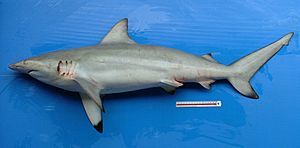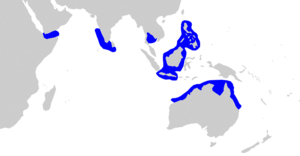Graceful shark facts for kids
Quick facts for kids Graceful shark |
|
|---|---|
 |
|
| Conservation status | |
| Scientific classification | |
| Genus: |
Carcharhinus
|
| Species: |
amblyrhynchoides
|
 |
|
| Range of the graceful shark | |
| Synonyms | |
|
Carcharias pleurotaenia Bleeker, 1952 |
|
The graceful shark or Queensland shark (Carcharhinus amblyrhynchoides) is a type of requiem shark. It belongs to the Carcharhinidae family. You can find this shark in the warm, tropical waters of the Indo-Pacific ocean. Its range stretches from the Gulf of Aden all the way to northern Australia. This shark lives in the middle of the water and has been seen as deep as 50 meters (160 feet).
The graceful shark is quite strong and can grow up to 1.7 meters (5.6 feet) long. It has a short, wedge-shaped snout. Its pectoral fins and first dorsal fin are large and shaped like a sickle. Most of its fins have black tips. Graceful sharks mainly eat bony fish. They also eat some cephalopods (like squid) and crustaceans (like crabs). Female graceful sharks give birth to live pups, usually up to 9 at a time. Their pregnancy lasts about 9 to 10 months. Off northern Australia, babies are born in January and February, and mating happens soon after. This shark could be dangerous, but it has never been involved in any shark attacks. People sometimes catch them by accident when fishing for other things. They are caught for their meat, fins, and shark liver oil. The International Union for the Conservation of Nature says this shark is "Near Threatened". This means it might become endangered in the future.
Contents
How it Got its Name
An Australian scientist who studies fish, named Gilbert Percy Whitley, first described the graceful shark in 1934. He called it Gillisqualus amblyrhynchoides. He wrote about it in a science magazine called Memoirs of the Queensland Museum. His description was based on a young female shark, about 60 centimeters (24 inches) long. This shark was caught near Cape Bowling Green in Queensland, Australia. That's why it's also called the Queensland shark. Later, other scientists decided that Gillisqualus was the same as Carcharhinus. So, the shark's name changed to Carcharhinus amblyrhynchoides.
Scientists often try to figure out how different shark species are related. In 1982, a scientist named Jack Garrick thought the graceful shark was most closely related to the blacktip shark. He also thought they were both close to the spinner shark. Another scientist, Leonard Compagno, agreed with this idea in 1988. However, newer studies using molecular phylogenetics (looking at DNA) have shown that these relationships might not be correct for all those sharks.
Where Graceful Sharks Live
The graceful shark lives in many places across the tropical Indo-Pacific region. They have been seen in the Gulf of Aden, near southwestern India and Sri Lanka, in the Gulf of Thailand, Vietnam, the Philippines, and around Borneo and Java. They also live from Papua New Guinea to northern Australia, specifically from Townsville to Eighty Mile Beach.
It's hard to tell graceful sharks apart from other similar sharks. Because of this, scientists think they might live in even more places than we currently know. The graceful shark is an open-water shark. It can be found close to shore or further out on the continental shelfs. They can swim down to at least 50 meters (160 feet) deep.
What Graceful Sharks Look Like
Even though it's called the "graceful shark," its body is actually quite "tubby" or spindle-shaped. It has a short, pointed snout that looks like a wedge. Its eyes are fairly large and round. They also have special nictitating membranes, which are like protective third eyelids. The shark's mouth has small grooves at the corners. Inside, it has 31 to 33 rows of teeth on the top jaw and 29 to 33 rows on the bottom jaw.
The upper teeth are narrow and have jagged edges. They stand straight up in the middle of the jaw but become more slanted towards the sides. The lower teeth are similar but usually straighter and thinner. The graceful shark has five pairs of long gill slits.
Its pectoral fins are shaped like sickles and have pointed tips. The first dorsal fin is tall and wide, with a pointed top. It starts roughly above where the pectoral fins end. The second dorsal fin is quite large and is located opposite the anal fin, which is about the same size. There is no ridge between its dorsal fins. The caudal fin (tail fin) has a well-developed lower part and a small notch near the tip of the upper part.
Graceful sharks are bronze-colored on top and white underneath. The white color extends onto their sides as a pale stripe. Their pectoral fins, dorsal fins, and the lower part of their tail fin usually have black tips. Sometimes, their pelvic fins also have black tips. The upper part of the tail fin gets darker towards the back edge. The anal fin might be completely light. These fin markings tend to fade as the shark gets older. The biggest graceful shark ever found was about 1.7 meters (5.6 feet) long.
Diet and Reproduction
The graceful shark mostly eats bony fish. Cephalopods (like squid) and crustaceans (like crabs) are not as important in their diet. In the Gulf of Carpentaria, over 60% of the fish they eat are jacks.
Like other sharks in its family, the graceful shark is viviparous. This means the mother gives birth to live young. When the baby sharks are growing inside the mother, they first use up their yolk for food. After the yolk is gone, the yolk sac changes into a special connection, like a placenta, to the mother. This allows the babies to get food and oxygen from her.
Off northern Australia, male and female graceful sharks probably mate every year in February. The females then release their eggs shortly after. Females usually have three pups at a time, but some have been seen with up to 9 babies. The young are born in January or February, after a pregnancy of 9 to 10 months. Both male and female graceful sharks are ready to have babies when they are about 1.1 to 1.2 meters (3.6 to 3.9 feet) long. A type of tapeworm called Cathetocephalus is known to be a parasite of this shark.
Graceful Sharks and Humans
Because of its size, the graceful shark could potentially be dangerous to humans. However, there have been no recorded shark attacks involving this species.
Graceful sharks are sometimes caught by accident by commercial fisheries in places like Thailand, India, and Sri Lanka. Fishermen use gillnets and longlines to catch other fish, and graceful sharks get caught too. In the mid-1980s, they made up a small part of shark catches off northern Australia. They were about 1.5% of sharks caught in gillnets and 0.2% on longlines. Catches in this area have gone down since the 1970s and 1980s. This is because foreign fishing boats left after new rules were put in place about gillnets.
The meat of the graceful shark is sold fresh or dried and salted. Their fins are sent to East Asia to be used in shark fin soup. Their liver is used to make vitamins. The International Union for the Conservation of Nature has listed the graceful shark as "Near Threatened". This means it's not endangered yet, but it could become so if we don't learn more about it and protect it. More information about its biology and how many are being caught is needed.
See also
 In Spanish: Tiburón grácil para niños
In Spanish: Tiburón grácil para niños


